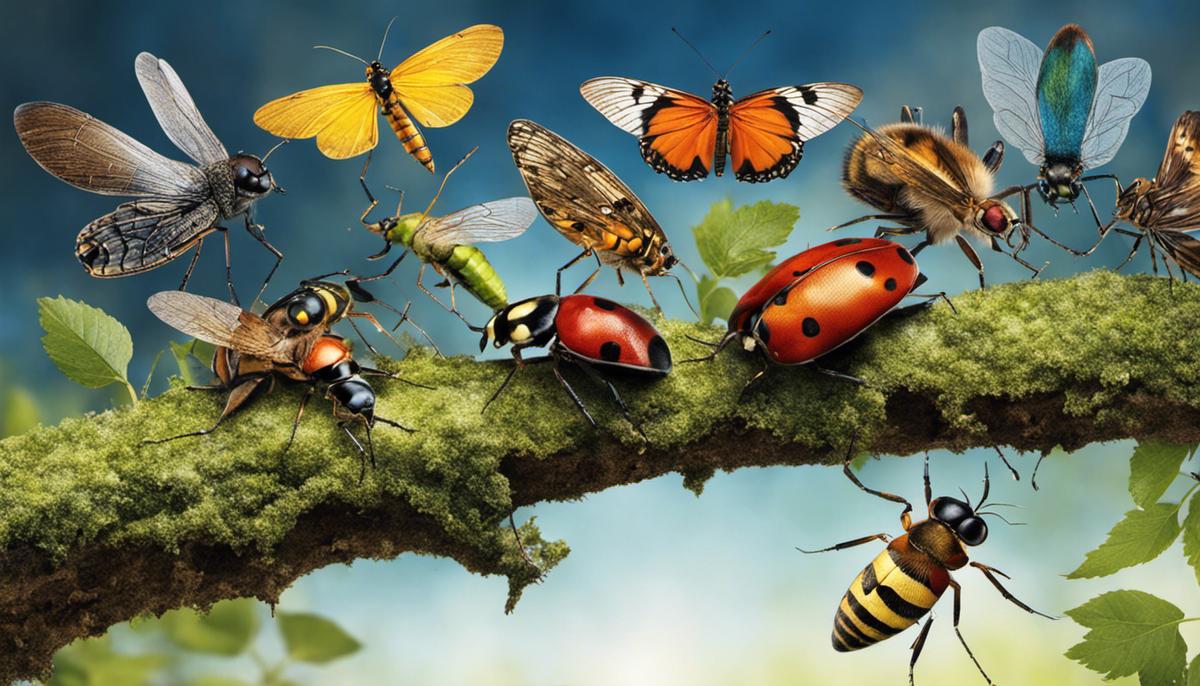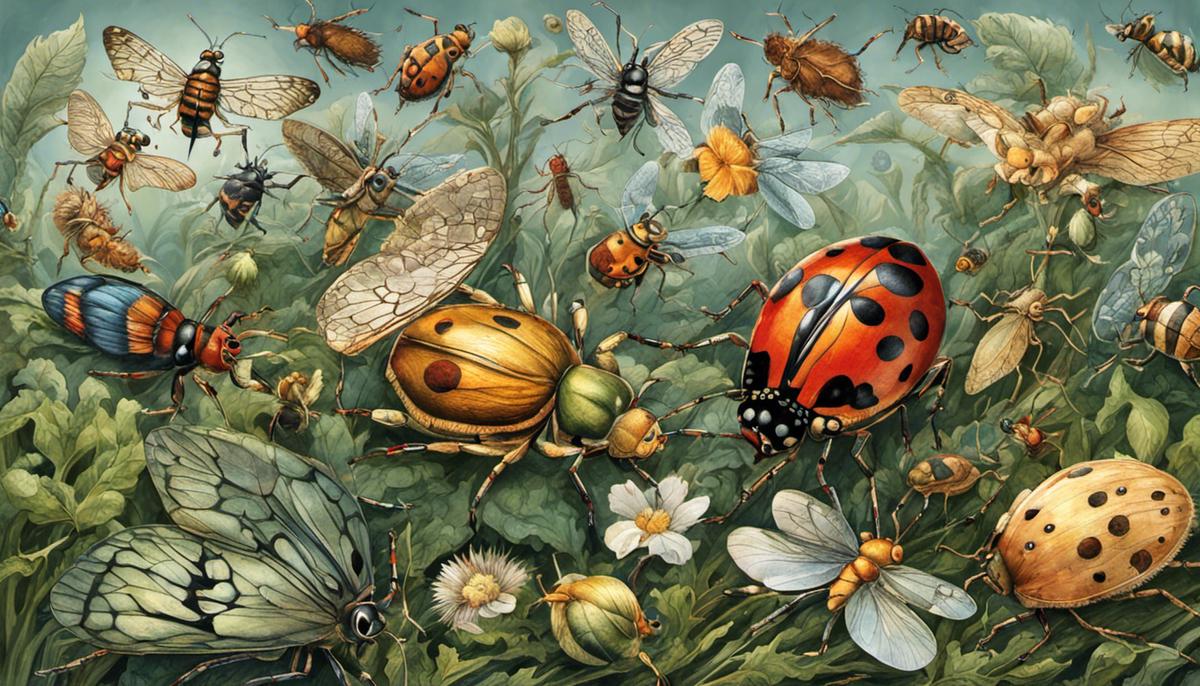Across centuries, dreams have been seen as messages and prophecies transcending the subconscious-particularly in religious contexts like the Bible. This enriching journey explores the largely uncharted territory of the symbolism of bugs in dreams, with a vibrant fusion of biblical and psychological perspectives.
We begin by delving into the concept of dreams in biblical perspective, illuminating their spiritual significance in stories of the Bible.
Next, we navigate through the intriguing landscape of Biblical symbolism of bugs-often encoded with messages of transformation, decay, or insignificance.
Transitioning into the realm of psychology, we will seek to understand what the presence of bugs in dreams can reveal about one’s inner emotional or mental state.
Ultimately, we will strive to synthesize these spiritual and psychological viewpoints, thus enriching our understanding of this rather peculiar dream symbolism. Open your mind and embrace the enigma that is the realm of dreams.
Concept of dreams in biblical perspective
The Perception and Interpretation of Dreams within the Biblical Context
Dreams, an enigmatic process of the subconscious mind, have been subjects of fascination across cultures and epochs. Within the biblical milieu, dreams hold a unique place, acting as conduits for divine messages and prophetic visions. This article aims to delve into the comprehensive understanding of dreams in biblical context and elucidate their interpretations.
Biblical narratives are replete with instances where dreams played integral roles. In Genesis, Joseph’s dreams stirred envy among his siblings, yet, latterly, it was his interpretation of dreams, including those of the Pharaoh, that personified his providential role in the salvation of nations. Daniel, too, was known for his dream interpretations, decoding the ominous handwriting on the wall for a perplexed Belshazzar.
Dreams in the biblical tradition were typically regarded as direct divine communications. The Midianites’ dream in Judges 7, for instance, presaged their defeat, which Gideon heard as a confirmation from God. The proclivity to perceive dreams as divine messages was rooted in a time when divine revelation was believed to be transmitted through more direct channels.
Yet, despite their perceived divine origin, dreams were not universally accepted as truth without discernment. The Deuteronomistic law warned against false prophets who might use dreams to divert the faithful. Similarly, the apocalyptic literature of Daniel and Revelation interpreted dreams symbolically, leading to an understanding of dreams as multi-layered narratives that demand careful interpretation.
As Isidore of Seville opined in his Etymologies, each dream has both literal and symbolic interpretations. Decoding these meanings could reveal divine messages. Such hermeneutic practices trace their roots back to Joseph and Daniel’s narrative examples.
However, it is crucial to note the shift in dream perception in the New Testament. Here, dreams are less prevalent and direct divine communication is more often portrayed through the physical and intellectual presence of Jesus Christ. However, dreams persist in certain contexts. The vision of Peter in Acts 10 encapsulated the nascent theology of Christian inclusivity, while the protective dreams sent to Joseph safeguarded the infant Jesus in Matthew’s gospel.
In conclusion, while elucidating the perception and interpretation of dreams within the biblical text, it becomes evident that they are regarded as a significant channel for divine communication, prediction, and guidance. However, this does not forego the necessity for discernment and interpretation. Thus, dreams in the bible serve as a fascinating interface of the divine and the human, opening windows for a broader understanding of religious experience and God’s communication methods.

Biblical symbolism of bugs
While dreams do indeed serve as a captivating nexus between the divine and the human in the Biblical canon, the underlying symbols within these dreams—such as insects—undoubtedly instigate a deeper exploration into their significance. The presence of bugs and insects in biblical text is not merely incidental; their inclusion bears specific—and profoundly fascinating—symbolic significances.
The physical characteristics of insects, along with their ecological roles, contribute substantially to shaping their biblical symbolism. Take, for instance, the locusts: these prodigious little entities are not only renowned for their catastrophic potential as pests but also for their migratory ability. In the context of the Bible, locusts are used symbolically to represent plague, destruction, or divine judgment, referencing several instances of locust infestations as divine chastisement (e.g., Exodus 10:1-20, Revelation 9:1-11).
Likewise, the ant’s diligent work ethic is highlighted upon in texts such as Proverbs 6:6-8, establishing them as symbols of industriousness and hard work. The proverbial “consider the ant” sentiment intensifies this hardworking ethos of insects, underlining the merits of persistence, diligence, and preparation.
However, insects also symbolize abstract qualities such as insignificance or triviality, as observed in texts referring to individuals as “worms” (e.g., Job 25:6, Isaiah 41:14). Despite their minuscule size and seeming lack of significance, an insect’s existence—much like every other creation—has its purpose within the grand scheme of the natural world, thus reinforcing the idea of universal inclusion.
Turning attention to dream interpretation, it is intriguing to note how the symbolism of insects in the Bible imbues richer depth to dream analysis within biblical contexts. For example, if one were to dream about locusts, it could be interpreted as impending destruction or divine judgment, tied back to their biblical symbolism. Observing ants in dreams, depending upon the nature of the situation, might impel individuals for self-reflection on their work ethic and preparation.
Of utmost importance, though, is to underscore the necessity of individual contextual interpretation in addition to these overarching themes. While the foundational meanings derived from biblical texts form a pertinent guideline for insect symbolism, one must also consider the individual’s unique circumstances and subconscious connotations when interpreting dreams— a challenging but fascinating dimension.
To this end, understanding the symbolism of insects in biblical contexts is of immense interest, spanning physical reality, human traits, morality, divine judgment, and the interpretation of dreams. Such exploration richly complements our understanding of the well-woven network of biblical narratives.

Bugs in dreams: Psychological perspectives
The craft of dream interpretation, as it persists in modern-day psychology, holds roots in ancient cultures and, of course, biblical narratives. The symbolism found in dreams, inclusive of insects, is an area that incites curiosity and deep analytical introspection. Under the lens of modern psychology, particularly psychoanalysis which owes its inception to Sigmund Freud, it is to be understood that dreams serve as the royal road to the unconscious, providing clues about hidden desires and repressed memories.
Insects, largely due to their diversity and ubiquity, have earned a place in the pantheon of dream symbols. Psychoanalytical theories often relate the presence of bugs in dreams to discomfort, perhaps due to repressed anxiety or unaddressed issues in waking life. Carl Jung, another stalwart of psychoanalysis, regarded dreams as a way of communicating with the unconscious, holding that the symbolism therein could be personal or archetypal, due to their recurring nature across diverse individuals.
Drawing on his approach, one should take into account one’s personal connotations with bugs while interpreting such dreams. For instance, a zoologist working with insects might harbor feelings of curiosity and fascination towards these organisms. Consequently, their dreams filled with bugs might embody these characteristics rather than the commonly perceived negativity.
It is also pertinent to differentiate between different types of bugs in dreams. According to psychology and dream interpretation studies, a dream filled with harmless butterflies might suggest a period of personal transformation, while a swarm of bees might indicate social pressures or a sense of productivity, due to the comparison of ‘busy as a bee’.
From a psychoanalytical standpoint, dreams about bugs could also denote thoughts and feelings from the subconscious related to “bugs in the system,” metaphorically indicating the existence of some issue or problem gnawing at the dreamer’s peace.
It might be tempting to regard these interpretations as universally applicable, but it falls short of acknowledging the impact of cultural contexts in dream symbolism. Just as the biblical values and connotations of bugs in dreams might differ from culture to culture, so might the interpretations from a psychological perspective.
For instance, in certain African cultures, seeing a spider in dreams often denotes wisdom, owing to the spider’s representation in African folktales. In contrast, Western cultures may interpret the same as a symbol of entanglement or feeling trapped due to the association of spiders with webs.
To conclude, the answer to the question at hand is shaped by diverse factors like cultural contexts and personal experiences. In addition, the understanding of bugs in a dream reflects the richness and complexity that stems from the interplay between psychology and the field of dream interpretation. Hence, it is more appropriate to consider it as a subjective, nuanced topic, rather than relying on oversimplified interpretations.

Integrating biblical and psychological interpretations
Delving into the realm of dream interpretation from a psychological standpoint often brings us to the work of acclaimed psychoanalysts: Sigmund Freud and Carl Jung. Freud proposed that dreams were wish fulfillment or distorted fulfillments of repressed desires. Jung, on the other hand, posited dreams as windows to the unconscious that could provide insight into one’s personal and collective unconscious.
Insects in dreams, for instance, may hold symbolism rooted in the individual’s psyche. A bug, in Jungian terms, can be a manifestation of the “shadow” aspect of the dreamer’s psyche – encapsulating qualities that are suppressed, denied, or deemed unacceptable. It bears a note here that the ‘shadow’ is not purely negative; it also encompasses latent talents and positive traits that are unrealized.
In specific regards to bugs in dreams, some psychological theories suggest that they represent anxieties, annoyances, or seemingly ‘small’ issues that have potential to cause disruption if ignored. They could denote feelings of annoyance, disgust or fear that may plague the dreamer in waking life.
Understanding the guise in which bugs appear in the dream is paramount in psychoanalytical interpretation. Different bugs hold different symbolic connotations. For instance, spiders might be an indication of a manipulative female figure or feelings of entrapment, while cockroaches could symbolize decay or an enduring issue.
Moving to a cultural perspective, the symbolism of bugs varies widely across cultures. In some, insects like the scarab beetles of ancient Egypt are revered as symbols of creation and resurrection while in others, they are thought to signify evil and corruption, underscoring the significance of understanding cultural contexts for accurate dream interpretation.
Nevertheless, the most crucial point to remember in dream interpretation is its inherently subjective nature. Dreams weave together a multitude of personal experiences, associations, emotions, and unconscious materials unique to the dreamer. Consequently, a universally applicable interpretation of bug symbolism in dreams remains elusive.
In making sense of bugs within our dreamscapes, reconciling both biblical symbolisms and psychological perspectives becomes a layered process. A dream, soaked in biblical symbolisms, may point toward divine revelations while from a psychological perspective, suggest unresolved personal issues or internal conflicts.
The table of concordance lies in interpreting the underlying theme rather than specific symbols. For instance, if bugs in biblical dreams suggest impending difficulties and, psychologically, represent anxieties, the congruent message might involve imminent challenges evoking anxiety.
Indeed, dream interpretation is as fascinating as it is complex. It obliges a fine balance between understanding religious, personal, cultural, and psychological contexts. As we continue to explore the enigmas of dreams and symbols, let us remember that dreams are deeply personal experiences, resonating the familiar dictum – the best person to interpret your dreams is oneself, given that they have accurate understanding of their emotional, spiritual, cultural, and personal landscape.

The mystical blend of biblical teachings and psychological interpretations brings a refreshing perspective to dream analysis. By exploring the thematic significance of bugs in both the Bible and in seminal psychological theories, we have unveiled an intricate tapestry of symbolic meanings.
The interpretative journey has taken us beyond the physicality of bugs acknowleding them as potent dream symbols echoing the human experiences of transformation, decay, or insignificance.
The presence of insects in dreams, once perceived as merely unusual or discomforting, can be observed as intriguing prompts for introspection, carrying in their tiny forms deeper insights about ourselves and our relationship with the divine.
Thus, each dreaming mind becomes a beautiful canvas where the spiritual and psychological hues mingle to paint surreal images laden with rich, symbolic narratives.







